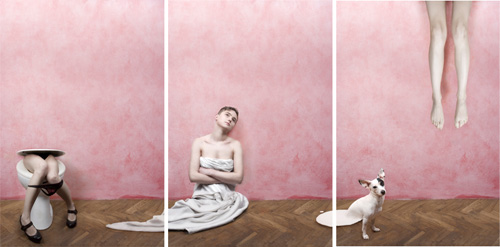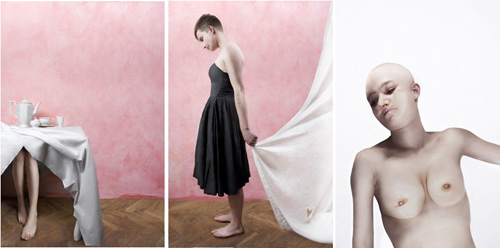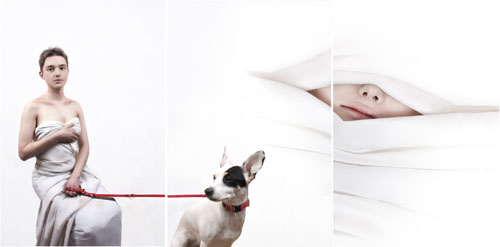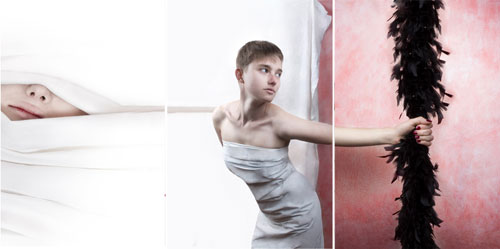 |
 |
 |
 |
 |
 |
 |
 |
| Between Reality and Postsurreality |
|
Paulina Hebda is a graduate of photographic studies at the Academy of Art in Gdańsk and the Film School in Łódź. She is a modern artist who would rather work with digital images and everything that goes with them than with old-fashioned analogous photos of different characteristics of which I shall mention merely the most important, like definite time, place and memorative values, understood as memory and relic of concrete human existence, as a form of human struggle with death1. Will this kind of photography die out? I shall return to this question later in this article.
Paulina Hebda took part a few times in the Cyberfoto competition in Częstochowa. In 2010 her works based on certain manipulations of the human body seemed stylistically similar to the art of other prize-winners, like Michał Piotrowski or, to a lesser extent, Kamila Żurawska-Chwiszczuk. At that time I wrote about Hebda’s art: “The second prize went to Paulina Hebda and her works from three series, Creation of Amber, Nude and Self-portrait. The female nude was used in surrealistic montages in which the human body was subjected to postsurrealistic transformations. Headless and armless phantoms came into being yet again, phantoms with displaced human organs like an ear or an eye. An attractive juxtaposition and transference of human limbs took place here. It is true that these works were assaulting in their literalness but ultimately turned out to be a very successful attempt at showing man’s anatomical interior and turned our attention to the threats of his biological nature which keeps undergoing further changes - as well as medical experiments. In Hebda’s case we can point to the influence of the art of Erwin Olaf, Veronika Bromova or the paintings by René Magritte.”2 These works, as far as I can remember, came into being while she was still a student in Gdańsk Formal means An extremely positive feature of Hebda’s most recent works from the series called Bajka [Fairy Tale] – created for her final exam at the Film School in Łódź, under the supervision of professor Grzegorz Przyborek – is the skillful use of form that rather refers to the rationalization of seeing and to the complicated world of emotions, expressed by static, sculpturesque takes, full of references to the tradition of old art, but also to painting as a genre and to a lesser extent, to surrealistic photography. Accessories that Hebda uses are simple, not to say ascetic. They paint life in its potentiality, including one’s life prospects. The purposeful use of a pink and – less frequently – white background is part of the plan to show this potential “theatre of life”. Tadeusz Kantor believed that the suggestive use of pink in Witold Wojtkiewicz’s painting Obłęd [Madness] came from a dream of the mentally disturbed artist3 . Did Kantor exaggerate with this interpretation? Certainly not in Wojtkiewicz’s case, but in Hebda’s works the use of suggestive colour is not so expressive, although the pessimism of her staged situations is very clear. The symbolism of black and white and of masking one’s face is equally important, as well as by deliberate fragmentation of the human body. This is a reference to the great – as far as expression and significance are concerned – paintings by Francis Bacon. For example, the toilet bowl and legs attached to it seems to illustrate the postmodern thesis of the end of man and his humanistic, i.e. also metaphysical values. However, Hebda does not give way to eclecticism or some phony forms of academic art nor is she too modernistic in constraining of the aura of art (in the sense of Walter Benjamin’s term). Let us look, then, at the delicate trails leading towards old art, for example at the draped ancient robes, at the skull and at Hebda’s still-life - though all interpreted in a modern, contemporary way. The narrative sequence of those works is also very good, as well as the deliberate transference of certain forms and meanings onto the next image in which Hebda - who at the same time renounces the mathematical perspective - changes the locations optically in order to undermine our faith in the reality of the image and moves its meaning towards an oneiric and sometimes surrealistic horror. Meanings of metaphors This sublime but disturbing and ambiguous vision has to do with what might potentially happen in life and is veiled in extreme pessimism. The world is diffused, it disappears, shifts towards disintegration. Beautiful bodies may be deformed or presented in an expressionist way (which may be connected with the programme of the grotesque which also conveys alienation and melancholy, but is interpreted in a surrealistic way). What does the problem of melancholy in Paulina Hebda’s photographs relate to? Not only to the fact that a beautiful body inevitably deteriorates in time, but also to the innocence of childhood, which passed away long ago, and to vague problems that appear later and that could lead even to suicide - which is subtly suggested by one of the works. Very interestingly interpreted surrealistic structures appear in those works, like graspers of a black lifeline which symbolizes our search for salvation and strongly influences our subconsciousness. Fragments of this line/liana can later be seen in the mouth of the model and seem to be the symptom of danger, not salvation, like in the previous picture. Other photographs can be brought down to existence and representation within the frame of the picture - but the model’s face does not appear in them. Therefore, the frame, and perhaps art as a whole, becomes a place where one can mysteriously exist and disappear, as in one of Lewis Carroll’s great ideas from Alice’s Adventures in Wonderland, which was often exploited by the surrealists. I do not see any randomness in Hebda’s works, nor do I see merely intuition behind them. These pictures emanate strong negative and – not as frequentl y – positive meanings, interchangeably. Order, the wish for harmony and rationality in the world and in one’s own life are contrasted here with expressionism and surrealism of the kind of Bacon’s and Magritte’s, though the potential of the former is in this case more significant. Magritte deliberately studied and conceptualized painting, performing linguistic and, from his perspective, semiotic and structuralistic operations on this branch of art. We see no such operations in Hebda’s works. The final photograph is especially interesting in the context of meanings. It is a portrait, classic in composition, with very good montage. The woman in the picture has no hair but she has a “mohawk” of flowers symbolizing freedom and the rejection of conventions. Can an ancient goddess hold a dog on a leash? The question may seem absurd, but not in surrealistic visions. We still need a collective myth, even if it be absurd. The surrealists of the 1920s and 1930s, like Max Ernst, Ubac or Dora Mahr as well as the artists from their circles (e.g. Pablo Picasso) tried to revive ancient gods and make them live in the present - which was obviously a utopian programme. Let us look at one of Hebda’s photographs in which we see a goddess or priestess swathed in a loose robe and holding a little dog on a red leash. That is how the traces or remnants of mythology are made to connect with the present. Or maybe this is only some allusive joke and a pastiche of an old artistic motif? Using digital techniques in a distanced way Hebda did not lose the ability to produce psychologically valid portraits. A large majority of contemporary artists, perhaps more graphic artists than photographers among them, intensifies the power of colour in their works and thus - often unconsciously - enhances the graphic quality of the image. Such artists forget that photography ought to be faithful to what it reproduces in spite of its aspirations to enter surrealism or New Objectivity and without declaring that one should be conscious of what one does or whether one wants to work in the sphere of traditional photography, graphic art or painting and to quite consciously violate their borders, like the American pop-artists in the 1960s. However, Polish artists who wanted to emulate pop-art were not aware of this. In surreality, art and life The phenomenon of surrealism is that although the surrealist movement started to fade away after the death of its guru – André Breton – in 1967, its influence and significance is still gigantic. It is absolutely certain that we will keep seeing postsurrealist exhibitions all over the world. The surrealists had created a great reservoir of images that “overflow” from our subconsciousness and reality. We can only hope that these suggestive pictures by Paulina Hebda will remain beyond the sphere of reality, within our imagination, and that they will not infiltrate our private lives. It depends only on us whether we will treat them as signs or symbols leading the viewer into the unknown. But such a dadaistic-surrealistic tradition could also be found in Poland, mainly in Łódź and mainly in the art of a formation called Kultura Zrzuty (the Chip-in Culture, ar. 1982-1990). Of course, commercial photography has been using the potential of surrealism since the 1930s. A very interesting feature of Hebda’s approach is that she combines thinking in terms of sculpture nad painting and skillfully uses the photographic technique, renouncing the distinction of a document4. She consciously refers to the tradition of “staged photography” in the sense of also the subject being staged, if you allow me to allude here to the famous classification of the German theoretician and photographer, Andreas Müller-Pohle, made in the 1980s5. Returning to the key question from the beginning of this text, the question about the existence of the concept of photography as a relic that opposes the tragedy of death and the misery of human existence, it is my belief that such a concept will never disappear until man and the so-called Judeo-Christian culture still exist. Man remains just a man and his myths are only myths which wither and fade away. Human existential problems remain, but art may help man to understand and overcome them. |
Krzysztof Jurecki |
|
1
Some theoreticians of photography are of this opinion, especially Roland Barthes. The meaning of the term “relic” in his work is correctly underscored by Sławomir Sikora, in: Fotografia. Między dokumentem a symbolem [Photography. Between a Document and a Symbol], Izabelin 2004. 2 K. Jurecki, Między realnością a symulacyjnością, Cyberfoto 2010. XIII Międzynarodowy Konkurs Fotografii Cyfrowej [Between Reality and Simulation, Cyberfoto 2010. 13th International Competition of Digital Photography, unnumbered pp., Częstochowa 2010, catalogue of the exhibition]. It is interesting that some of prize-winning works by Hebda were produced as advertisements of artistic jewellery. What was important here was most of all the skillful use of the classic nude and professional lighting of the body so that it (the body) would resemble a plastic model overlaid with a surrealistic obsession in the form of a feral montage of anatomical forms. And these works have been presented at a few individual and group exhibitions. 3 Kantor’s hypothesis was presented in the film by Krzysztof Miklaszewski entitled Tadeusz Kantor. Moja historia sztuki. Lekcja Wojtkiewicza [Tadeusz Kantor. My History of Art. A Class on Wojtkiewicz], written and narrated by Krzysztof Miklaszewski, OTV Cracow, 1986. 4 Such a compositional balance, its concrete style and references to numerous aspects of medium analysis make me think of the influence of the pedagogic concept of professor Grzegorz Przyborek, one of the most influential academic teachers of artistic photography in Poland. 5 Andreas Muller-Pohle, Fotografia inscenizująca [Staging Photography], transl. by S. Wojnecki, in: Inscenizacje. Współczesna fotografia w Republice Federalnej Niemiec [Stagings. Contemporary Photography in the Federal Republic of Germany], Stara Galeria ZPAF and others, Warsaw 1988 (catalogue of the exhibition). Please notice that the term “fotografia inscenizująca” is broader than its English or Dutch equivalent (and that “staging photography” has a broader meaning than “staged photography”). |
Copyright ©2012 Galeria FF ŁDK i Autorzy |